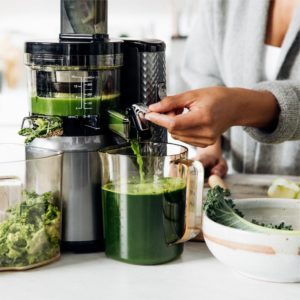The best juicers correspond to your specific juicing needs. Obtaining a juicer that fits your space, needs, and preferences will help you get the most out of your budget, regardless of whether you are a dedicated juicer who presses fruits and vegetables day and night or a casual celery juice enthusiast.
Before purchasing your first (or subsequent) juicer, learn more about the three primary types. Individual machines may have unique features or characteristics, but their fundamental functions will fall into three categories: centrifugal, masticating, or triturating. The extraction methods, speeds, juice quality, and decibel levels of these juicers vary.
The best juicer for you may also depend on your willingness to invest. Juicing and juicers can be expensive. Expensive juicers are an initial investment, but many are designed to extract the maximum amount of juice from your produce. In the end, this will save you money and reduce food waste. Less expensive juicers may be cheaper out of pocket, but they may not produce as much juice. In the end, you will need more fruit to obtain the desired amount of juice.
Learn about the three most common types of juicers, their pros and cons, and which features you should look for if you’re in the market for a juicer.
Variety of Juicers
Centrifugal Juicers
Produce is pulverized with tiny teeth on a rapidly spinning basket in centrifugal juicers. The juice is then pressed through a sieve with a fine mesh. This method produces a great deal of foam, which some find unappealing or believe contributes to the oxidation of their juice. Carrots, apples, and other hard fruits and vegetables are ideal for centrifugal juicers, as opposed to high-fiber leafy greens such as wheatgrass and kale.
Most centrifugal juicers are lightweight, simple to assemble and operate, and have dishwasher-safe removable parts. These juicers tend to be loud, which could be a problem if you’re juicing early in the morning while others are sleeping. Centrifugal juicers are typically the cheapest and ideal for beginners; quality models begin at $50.
Masticating Juicers
Using augers with sharp metal teeth, masticating juicers mimic the action of “chewing” fruits and vegetables. They then extract as much juice as possible from the pulp, producing high yields with minimal foaming and oxidation. This slow juicer technique makes it simple to remove juice from wheatgrass, spinach, and kale, among other leafy greens. Masticating juicers, also known as “cold-press” juicers, produce juice more slowly but without heating it. It is believed that doing so will preserve more nutrients in the final juice.
These juicers are typically quieter and operate with a low hum. Their more expensive, powerful motors enable additional features, such as making nut butter, baby food, sorbets, and even pasta. Masticating juicers are an investment and cost more than $200.
Triturating Juicers
If you cannot survive a day without a glass of fresh juice, a triturating juicer may be the best for you. Utilizing twin rotating gears, these juicers crush, and grind produce into beautiful particles. The gears then extract the maximum amount of juice from the food particles, leaving behind dehydrated pulp and high-quality juice. This type of juicer is especially effective with fibrous vegetables and leafy greens, but it can also extract a substantial amount of juice from soft fruits.
Like a masticating juicer, a triturating juicer is much quieter than a centrifugal juicer; however, it has a larger footprint than other types of juicers; most of these machines are horizontal juicers and require more space on your countertop or in your pantry.
As a compromise, many of these juicers are also capable of performing a variety of other functional culinary tasks, including grinding seeds and nuts and chopping vegetables. If you believe this is the appropriate juicer, be prepared to invest. Most models begin at approximately $400 and can easily cost several thousand dollars.
How to choose the best juicer for you
Yield/Type of Produce
Consider the types of juice you’d like to make most often and look for a juicer with a high yield for the produce you’ll be juicing when deciding which type of juicer to purchase. Masticating juicers are ideal for juicing leafy greens because they produce large quantities of dry pulp, resulting in less juice waste and lower long-term costs. A high-quality, less expensive centrifugal juicer may be your best bet if you’re only juicing fruits and hard vegetables.
Size and Storage
The location where you intend to store your juicer and the ease with which it can be accessed are also essential considerations. Horizontal masticating juicers can produce large quantities of juice, but they may not fit in your kitchen. They are typically heavier and more challenging to move from the closet to the counter.
On the other hand, the small footprint of vertical juicers makes them ideal for smaller kitchens with limited counter space; they often fit easily under cabinets. Lightweight centrifugal models are suitable for moving the juicer from storage to the countertop.
Ensure that the model you choose can accommodate the amount of juice you intend to produce: Less efficient juicers have less juice per batch.
Speed and Noise
Ensure that the speed and volume of your juicer are compatible with your lifestyle. Masticating juicers are much quieter than centrifugal juicers, so you should not disturb other household members while you juice. However, speed may be an issue if you need to make your juice quickly and freshly in the morning.
Some centrifugal juicers can juice an apple in 30 seconds while masticating juicers require longer. Multiple-speed juicers are advantageous because they extract the most juice from your produce. Slow juicer speeds are ideal for juicing soft fruits like grapes and strawberries, whereas high rates are ideal for firmer fruits and vegetables like apples and carrots.
Ease of Use/Cleanup
Juicers that are simple to assemble, operate, disassemble and clean will be utilized more frequently. Complex juicers may be stored at the back of a closet. However, the additional assembly may be worthwhile if you want a juicer that can make nut butter, sorbets, or baby food.
Large feed tubes on juicers significantly reduce the time required to prepare and feed produce into the machine. Juicers with external pulp containers enable continuous juicing without pausing to remove pulp.
Cleaning a juicer can be difficult; therefore, models with specialized brushes that make cleaning easier and dishwasher-safe models are always advantageous.
Price
Juicers range in price from as little as $50 to as much as $1000 for high-end models. The higher the price, the greater the juice yield and the drier the pulp. The amount you are willing to invest depends on how frequently you intend to use the machine and the types of fruits and vegetables you plan to juice.
Considering the cost of juicing over time and the initial cost of the juicer is essential. With low-yield juicers, you’ll spend significantly more on fruits and vegetables. Expensive juicers typically include a lengthy warranty to ensure years of high-quality juice extraction.
How to Choose the best Juicer for you - FAQs
Masticating juicers work best for leafy greens, producing high amounts of dry pulp, which mean less juice waste and lower cost in the long term. If you’ll only be juicing fruits and hard vegetables, a high-quality, less expensive centrifugal juicer may be your best bet
So-called slow juicers (a.k.a. masticating juicers) are generally considered superior in terms of extracting nutrients from fruits, vegetables and greens. Mantilla adds that “unlike a cold-pressed juicer, this juicer is fast.
If any food gets stuck inside the juicer, do not attempt to remove it by hand – instead, use a food pusher. Make sure the cover is secured before you switch the juicer on. Never use the juicer outdoors, and make sure it is placed on a cool, dry surface, Always turn off the pie maker at the socket when not in use.
Some claim that the cold press juicer offers a higher quality juice due to its pulp, and extra nutrients. The slow juicer is much quieter than its fast juicing counterpart.
Centrifugal juicers like the Breville Juice Fountain are ideal for grating hard fruits and vegetables (think apples and carrots). But then there are masticating juicers, like the fabulous Omega Quiet Dual-Stage Slow Speed Masticating Juicer. These models are excellent for softer leafy greens, like spinach or kale.
Here’s how these common types of juicers work: Both of these juicers extract juice from produce by forcing it against a sharp screen. A centrifugal juicer uses centrifugal force (by spinning very fast). Masticating juicers use a slow turning screw to force the produce against the screen.
They say juicing can reduce your risk of cancer, boost your immune system, remove toxins from your body, aid digestion and help you lose weight. However, there’s no scientific evidence that extracted juices are healthier than the juice you get by eating the fruit or vegetable itself.
More extreme juice cleanses are associated with negative side effects, including diarrhea, nausea, dizziness, and fatigue. There is no evidence that juice cleanses are necessary for detoxifying the body. Also, juicing may harm people who have kidney problems or take certain medications.
How long does fresh juice last? If want to preserve your freshly squeezed juice without freezing it, you can keep it in the refrigerator for three days. If you’re freezing your juice it can last between 12 to 16 months.
Should I choose a juicer or a blender?
Juicers and blenders are two special kitchen appliances designed for distinct purposes. A juicer extracts liquid from fruits and vegetables while leaving the solid pulp behind. Everything is emulsified into a smooth drink using a blender.
Blenders are ideal for making nutritious smoothies. They are typically less expensive than juicers, take up less kitchen space, and are easier to clean. As the fruit or vegetable fiber remains intact, your blended beverage will keep you fuller for longer, and you can add other ingredients such as ice, milk, nuts, seeds, and vitamin supplements that have been crushed to create delicious drinks.
However, many vegetables, including carrots, parsnips, and sweet potatoes, are unsuitable for blending and should be juiced instead.
Related Posts
Best Masticating Juicer On The Market Today
Disclaimer: There are affiliate links in this post. At no...
Read MoreBest Cold Press Juicer For Making Fresh, Delicious Juice At Home
Disclaimer: There are affiliate links in this post. At no...
Read MoreBest Electric Citrus Juicer For Every Budget
Disclaimer: There are affiliate links in this post. At no...
Read MoreWhy Trust Us
You will find what you are looking for at dulceriabakery. From classic to luxury brands, you'll find both. We will help you to select appliances that fit your needs, budget and lifestyle. Whether you want to stop by to learn more — or plan to make a major purchase — we’ll treat you like family and assist you every step of the way. Shop with us today to receive friendly and experienced help along the way.



